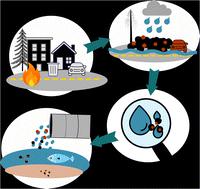当前位置:
X-MOL 学术
›
Environ. Sci.: Processes Impacts
›
论文详情
Our official English website, www.x-mol.net, welcomes your
feedback! (Note: you will need to create a separate account there.)
Wildland–urban interface wildfire increases metal contributions to stormwater runoff in Paradise, California
Environmental Science: Processes & Impacts ( IF 4.3 ) Pub Date : 2024-02-05 , DOI: 10.1039/d3em00298e Lauren J Magliozzi 1 , Sandrine J Matiasek 2 , Charles N Alpers 3 , Julie A Korak 1 , Diane McKnight 1 , Andrea L Foster 4 , Joseph N Ryan 1 , David A Roth 5 , Peijia Ku 6 , Martin Tsz-Ki Tsui 7 , Alex T Chow 8 , Jackson P Webster 9
Environmental Science: Processes & Impacts ( IF 4.3 ) Pub Date : 2024-02-05 , DOI: 10.1039/d3em00298e Lauren J Magliozzi 1 , Sandrine J Matiasek 2 , Charles N Alpers 3 , Julie A Korak 1 , Diane McKnight 1 , Andrea L Foster 4 , Joseph N Ryan 1 , David A Roth 5 , Peijia Ku 6 , Martin Tsz-Ki Tsui 7 , Alex T Chow 8 , Jackson P Webster 9
Affiliation

|
The 2018 Camp Fire was a large late-year (November) wildfire that produced an urban firestorm in the Town of Paradise, California, USA, and destroyed more than 18 000 structures. Runoff from burned wildland areas is known to contain ash, which can transport contaminants including metals into nearby watersheds. However, due to historically infrequent occurrences, the effect of wildland-urban interface (WUI) fires, such as the Camp Fire, on surface water quality has not been well-characterized. Therefore, this study investigated the effects of widespread urban burning on surface water quality in major watersheds of the Camp Fire area. Between November 2018 and May 2019, 140 surface water samples were collected, including baseflow and stormflow, from burned and unburned watersheds with varying extent of urban development. Samples were analyzed for total and filter-passing metals, dissolved organic carbon, major anions, and total suspended solids. Ash and debris from the Camp Fire contributed metals to downstream watersheds via runoff throughout the storm season. Increases in concentration up to 200-fold were found for metals Cr, Cu, Ni, Pb, and Zn in burned watersheds compared to pre-fire values. Total concentrations of Al, Cd, Cu, Pb, and Zn exceeded EPA aquatic habitat acute criteria by up to 16-fold for up to five months after the fire. To assess possible transport mechanisms and bioavailability, a subset of 18 samples was analyzed using four filters with nominal pore sizes ranging from 0.22 to 1.2 μm to determine the particulate size distribution of metals. Trace and major metals (Al, Ba, Co, Cr, Cu, Fe, Hg, Mn, Ni, Pb, and Zn) were found mostly associated with larger grain sizes (>0.45 μm), and some metals (Al, Cr, Fe, and Pb) also included a substantial colloidal phase (0.22 to 0.45 μm). This study suggests that fires in the wildland–urban interface increase metal concentrations, mainly through particulate driven transport. The metals with the largest increases are likely from anthropogenic disaster materials, though biomass ash also is a major contributor to water quality. The increase in metals following WUI burning may have adverse ecological impacts.
中文翻译:

荒地与城市交界处的野火增加了加利福尼亚州天堂市雨水径流中的金属含量
2018 年营火是年末(11 月)发生的一场大型野火,在美国加利福尼亚州天堂镇引发了一场城市大火,并摧毁了 18,000 多座建筑物。众所周知,被烧毁的荒地地区的径流含有灰烬,这些灰烬可以将包括金属在内的污染物输送到附近的流域。然而,由于历史上很少发生,荒地与城市界面(WUI)火灾(例如坎普火灾)对地表水质量的影响尚未得到很好的描述。因此,本研究调查了大面积城市燃烧对营火地区主要流域地表水质的影响。 2018年11月至2019年5月期间,从城市发展程度不同的已烧和未烧流域采集了140个地表水样本,包括基流和暴雨流。分析样品中的总金属和通过过滤器的金属、溶解的有机碳、主要阴离子和总悬浮固体。在整个风暴季节,营火产生的灰烬和碎片通过径流向下游流域输送金属。与火灾前相比,燃烧流域中金属 Cr、Cu、Ni、Pb 和 Zn 的浓度增加了 200 倍。火灾发生后五个月内,铝、镉、铜、铅和锌的总浓度超过 EPA 水生栖息地急性标准达 16 倍。为了评估可能的传输机制和生物利用度,使用四个标称孔径范围为 0.22 至 1.2 μm 的过滤器对 18 个样品的子集进行了分析,以确定金属的颗粒尺寸分布。痕量金属和主要金属(Al、Ba、Co、Cr、Cu、Fe、Hg、Mn、Ni、Pb 和 Zn)被发现大多与较大晶粒尺寸(>0.45 μm),一些金属(Al、Cr、Fe 和 Pb)还包含大量胶体相(0.22 至 0.45 μm)。这项研究表明,荒地与城市交界处的火灾主要通过颗粒驱动的运输增加了金属浓度。增幅最大的金属可能来自人为灾害物质,尽管生物质灰烬也是水质的主要贡献者。 WUI 燃烧后金属含量的增加可能会对生态产生不利影响。
更新日期:2024-02-05
中文翻译:

荒地与城市交界处的野火增加了加利福尼亚州天堂市雨水径流中的金属含量
2018 年营火是年末(11 月)发生的一场大型野火,在美国加利福尼亚州天堂镇引发了一场城市大火,并摧毁了 18,000 多座建筑物。众所周知,被烧毁的荒地地区的径流含有灰烬,这些灰烬可以将包括金属在内的污染物输送到附近的流域。然而,由于历史上很少发生,荒地与城市界面(WUI)火灾(例如坎普火灾)对地表水质量的影响尚未得到很好的描述。因此,本研究调查了大面积城市燃烧对营火地区主要流域地表水质的影响。 2018年11月至2019年5月期间,从城市发展程度不同的已烧和未烧流域采集了140个地表水样本,包括基流和暴雨流。分析样品中的总金属和通过过滤器的金属、溶解的有机碳、主要阴离子和总悬浮固体。在整个风暴季节,营火产生的灰烬和碎片通过径流向下游流域输送金属。与火灾前相比,燃烧流域中金属 Cr、Cu、Ni、Pb 和 Zn 的浓度增加了 200 倍。火灾发生后五个月内,铝、镉、铜、铅和锌的总浓度超过 EPA 水生栖息地急性标准达 16 倍。为了评估可能的传输机制和生物利用度,使用四个标称孔径范围为 0.22 至 1.2 μm 的过滤器对 18 个样品的子集进行了分析,以确定金属的颗粒尺寸分布。痕量金属和主要金属(Al、Ba、Co、Cr、Cu、Fe、Hg、Mn、Ni、Pb 和 Zn)被发现大多与较大晶粒尺寸(>0.45 μm),一些金属(Al、Cr、Fe 和 Pb)还包含大量胶体相(0.22 至 0.45 μm)。这项研究表明,荒地与城市交界处的火灾主要通过颗粒驱动的运输增加了金属浓度。增幅最大的金属可能来自人为灾害物质,尽管生物质灰烬也是水质的主要贡献者。 WUI 燃烧后金属含量的增加可能会对生态产生不利影响。











































 京公网安备 11010802027423号
京公网安备 11010802027423号